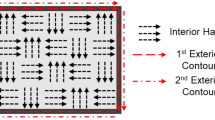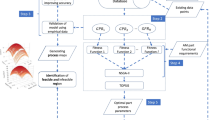Abstract
Due to the unique capability of producing parts with complex geometries and functionally graded materials, additive manufacturing (AM) is taking the leading role in the “third industrial revolution” and has attracted significant attentions in multiple industrial sectors. Part quality and energy consumption are two highly interdependent outcomes, and thus it is difficult to improve one without changing the other. However, to the best of our knowledge, prior pertinent studies usually considered and optimized quality and energy consumption individually. This proposed study aims to (1) obtain a fundamental quantitative relationship between AM process design parameters and AM part quality as well as process energy consumption, and (2) develop a general framework to optimize energy consumption in AM fabrication without compromising part quality (i.e., geometric accuracy). Linear regression models are used to capture the relationship between process design parameters and the part quality and energy consumption, respectively. Then, a non-linear optimization framework is proposed to minimize the energy consumption on the part level given specific quality requirements. A case study developed based on a fused filament fabrication (FFF) process and a specific part design is used to illustrate the effectiveness of the proposed methodology. The effects of quality requirements on the optimal energy consumption solution are also explored in the case study.
Similar content being viewed by others
References
Kruth J-P, Leu M-C, Nakagawa T (1998) Progress in additive manufacturing and rapid prototyping. CIRP Ann 47(2):525–540
Berman B (2012) 3-D printing: the new industrial revolution. Bus Horiz 55(2):155–162
ASTM (2012) F2792-12a standard terminology for additive manufacturing technologies. In: ASTM international. West Conshohocken, Pennsylvania
Yoon H-S, Lee J-Y, Kim H-S, Kim M-S, Kim E-S, Shin Y-J, Chu W-S, Ahn S-H (2014) A comparison of energy consumption in bulk forming, subtractive, and additive processes: review and case study. Int J Precision Eng Manuf Green Technol 1(3):261–279
Cotteleer M, Joyce J (2014) 3D opportunity: additive manufacturing paths to performance, innovation, and growth. Deloitte Rev 14:5–19
Wohlers T, Caffrey T (2015) Wohlers report 2015 : 3D printing and additive manufacturing state of the industry annual worldwide progress report. Wohlers Associates
Schoffer F (2016) Is 3D printing the next industrial revolution? . https://techcrunch.com/2016/02/26/is-3d-printing-the-next-industrial-revolution/
Tootooni MS, Dsouza A, Donovan R, Rao PK, Kong ZJ, Borgesen P (2017) Classifying the dimensional variation in additive manufactured parts from laser-scanned three-dimensional point cloud data using machine learning approaches. J Manuf Sci Eng 139(9):091005
Sreenivasan R, Goel A, Bourell DL (2010) Sustainability issues in laser-based additive manufacturing. Phys Procedia 5:81–90
Paul R, Anand S (2012) Process energy analysis and optimization in selective laser sintering. J Manuf Syst 31(4):429–437
Dunaway D, Harstvedt JD, Ma J A preliminary experimental study of additive manufacturing energy consumption. In: ASME 2017 International Design Engineering Technical Conferences and Computers and Information in Engineering Conference, 2017. American Society of Mechanical Engineers, pp V004T005A013-V004T005A013
Luo Y, Leu M, Ji Z (1999) Assessment of environmental performance of rapid prototyping and rapid tooling processes. In: Proceedings of solid freeform fabrication symposium, pp 783–792
Cho H, Park W, Choi B, Leu M-C (2000) Determining optimal parameters for stereolithography processes via genetic algorithm. J Manuf Syst 19(1):18–27
Duflou JR, Sutherland JW, Dornfeld D, Herrmann C, Jeswiet J, Kara S, Hauschild M, Kellens K (2012) Towards energy and resource efficient manufacturing: a processes and systems approach. CIRP Ann Manuf Technol 61(2):587–609
Sreenivasan R, Bourell D (2010) Sustainability study in selective laser sintering- an energy perspective. Minerals, Metals and Materials Society/AIME, 420 Commonwealth Dr., P. O. Box 430 Warrendale PA 15086 USA,
Vijayaraghavan A, Dornfeld D (2010) Automated energy monitoring of machine tools. CIRP Ann 59(1):21–24
Wang Q, Liu F, Li C (2013) An integrated method for assessing the energy efficiency of machining workshop. J Clean Prod 52:122–133
Meteyer S, Xu X, Perry N, Zhao YF (2014) Energy and material flow analysis of binder-jetting additive manufacturing processes. Procedia CIRP 15:19–25
Verma A, Rai R (2013) Energy efficient modeling and optimization of additive manufacturing processes. In: Solid freeform fabrication symposium, Austin, pp 231–241
Ajay J, Song C, Rathore AS, Zhou C, Xu W (2017) 3DGates: an instruction-level energy analysis and optimization of 3D printers. ACM SIGOPS Operating Systems Review 51(2):419–433
Baumers M, Tuck C, Bourell D, Sreenivasan R, Hague R (2011) Sustainability of additive manufacturing: measuring the energy consumption of the laser sintering process. Proc Inst Mech Eng B J Eng Manuf 225(12):2228–2239
Baumers M, Tuck C, Wildman R, Ashcroft I, Hague R (2011) Energy inputs to additive manufacturing: does capacity utilization matter. Eos 1000(270):30–40
Telenko C, Conner Seepersad C (2012) A comparison of the energy efficiency of selective laser sintering and injection molding of nylon parts. Rapid Prototyp J 18(6):472–481
Mognol P, Lepicart D, Perry N (2006) Rapid prototyping: energy and environment in the spotlight. Rapid Prototyp J 12(1):26–34
Xu X, Meteyer S, Perry N, Zhao YF (2015) Energy consumption model of binder-jetting additive manufacturing processes. Int J Prod Res 53(23):7005–7015
Baumers M, Tuck C, Wildman R, Ashcroft I, Hague R (2017) Shape complexity and process energy consumption in electron beam melting: a case of something for nothing in additive manufacturing? J Ind Ecol 21(S1):S157–S167
Yang Y, Li L, Pan Y, Sun Z (2017) Energy consumption modeling of stereolithography-based additive manufacturing toward environmental sustainability. J Ind Ecol 21(S1):S168–S178
Sabourin E, Houser SA, Helge Bøhn J (1996) Adaptive slicing using stepwise uniform refinement. Rapid Prototyp J 2(4):20–26
Zhou M, Xi J, Yan J (2004) Adaptive direct slicing with non-uniform cusp heights for rapid prototyping. Int J Adv Manuf Technol 23(1–2):20–27
Ma W, But W-C, He P (2004) NURBS-based adaptive slicing for efficient rapid prototyping. Comput Aided Des 36(13):1309–1325
Panhalkar N, Paul R, Anand S (2014) Increasing part accuracy in additive manufacturing processes using a kd tree based clustered adaptive layering. J Manuf Sci Eng 136(6):061017
Siraskar N, Paul R, Anand S (2015) Adaptive slicing in additive manufacturing process using a modified boundary octree data structure. J Manuf Sci Eng 137(1):011007
Lanzotti A, Martorelli M, Staiano G (2015) Understanding process parameter effects of reprap open-source three-dimensional printers through a design of experiments approach. J Manuf Sci Eng 137(1):011017
Huang Q, Nouri H, Xu K, Chen Y, Sosina S, Dasgupta T (2014) Statistical predictive modeling and compensation of geometric deviations of three-dimensional printed products. J Manuf Sci Eng 136(6):061008
Bi Z, Wang L (2010) Advances in 3D data acquisition and processing for industrial applications. Robot Comput Integr Manuf 26(5):403–413
Colosimo BM (2017) Modeling and monitoring methods for spatial and image data. Qual Eng (just-accepted)
Li Y, Gu P (2004) Free-form surface inspection techniques state of the art review. Comput Aided Des 36(13):1395–1417
Tootooni MS, Dsouza A, Donovan R, Rao PK, Kong ZJ, Borgesen P Assessing the geometric integrity of additive manufactured parts from point cloud data using spectral graph theoretic sparse representation-based classification. In: ASME 2017 12th International Manufacturing Science and Engineering Conference collocated with the JSME/ASME 2017 6th International Conference on Materials and Processing, 2017. American Society of Mechanical Engineers, pp V002T001A042-V002T001A042
Khanzadeh M, Rao P, Jafari-Marandi R, Smith BK, Tschopp MA, Bian L Quantifying geometric accuracy with unsupervised machine learning: using self-organizing map on fused filament fabrication additive manufacturing parts. Journal of Manufacturing Science and Engineering
Aboutaleb AM, Tschopp MA, Rao PK, Bian L (2017) Multi-objective accelerated process optimization of part geometric accuracy in additive manufacturing. J Manuf Sci Eng 139(10):101001
AIA/NAS (1969) NAS 979 uniform cutting tests - NAS series metal cutting equipment specifications. Aerospace Industries Association of America Inc, Arlington Standard No AIA/NAS-NAS979
Cavanaugh JE (2009) Model selection: Bayesian information criterion. Wiley StatsRef: Statistics Reference Online
Wold S, Sjöström M, Eriksson L (2001) PLS-regression: a basic tool of chemometrics. Chemom Intell Lab Syst 58(2):109–130
Acknowledgments
Furthermore, the authors would like to acknowledge Miss Abby Hatley for her contribution in the 3D modeling and energy consumption data collection.
Funding
This research is partially supported by the Undergraduate Research Program offered by the Office of Research and Economic Development, Mississippi State University.
Author information
Authors and Affiliations
Corresponding author
Additional information
Publisher’s note
Springer Nature remains neutral with regard to jurisdictional claims in published maps and institutional affiliations.
Rights and permissions
About this article
Cite this article
Tian, W., Ma, J. & Alizadeh, M. Energy consumption optimization with geometric accuracy consideration for fused filament fabrication processes. Int J Adv Manuf Technol 103, 3223–3233 (2019). https://doi.org/10.1007/s00170-019-03683-5
Received:
Accepted:
Published:
Issue Date:
DOI: https://doi.org/10.1007/s00170-019-03683-5




